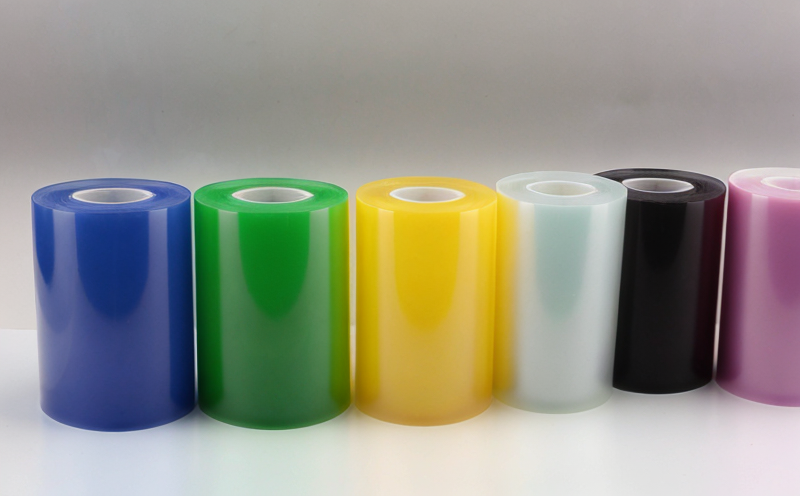ISO 4589 Oxygen Index Flammability Testing of Plastic Films
The ISO 4589 oxygen index test is a critical method used to determine the flammability properties of plastic films. This test evaluates how easily a material will burn in a controlled atmosphere, providing valuable information for quality management and compliance officers involved in product development.
The oxygen index measures the minimum concentration of oxygen required in a mixture (nitrogen/oxygen) to support steady flaming combustion of a specimen under specified conditions. For plastic films, this test is essential as it helps identify materials that might pose fire hazards when exposed to heat or flame, which can be particularly important for safety-critical applications such as packaging and construction.
The procedure involves placing the sample between two parallel plates in a chamber where oxygen content can be precisely controlled. The sample is ignited at one end with an open flame source. As the test progresses, the percentage of oxygen is gradually increased until the flame goes out. The oxygen index value represents this critical point and indicates the flammability characteristics of the material.
Proper specimen preparation is crucial for accurate results. Samples should be cut to standard dimensions ensuring they have a uniform thickness and surface finish. Environmental factors such as temperature, humidity, and storage conditions can affect test outcomes; therefore, controlled environments are necessary to ensure consistency and reproducibility.
The equipment used in ISO 4589 testing includes a chamber with adjustable oxygen content, an igniter for initiating the flame, and sensors or photodetectors to monitor when the flame extinguishes. Calibration of this apparatus is essential to maintain accuracy over time.
Understanding the results involves interpreting the oxygen index value, which indicates the minimum concentration of oxygen required for steady burning. Higher values suggest lower flammability, making them desirable properties in many applications. Conversely, lower indices imply greater susceptibility to ignition and flame spread, highlighting potential risks related to fire safety.
This testing method is widely recognized across various industries where plastic films are used, including packaging, electronics manufacturing, automotive components, and construction materials. By understanding the flammability behavior of these materials early in the design process through ISO 4589 tests, manufacturers can make informed decisions about material selection that balance performance requirements with safety considerations.
For instance, in the electronics sector, ensuring that flexible circuit boards used in mobile devices do not ignite under accidental ignition sources is paramount. Similarly, in construction, knowing which plastics will remain stable during installation processes without catching fire enhances overall project safety standards.
Accurate and reliable data generated from ISO 4589 tests play a vital role in certification processes ensuring compliance with national and international regulations regarding material flammability limits. This information helps companies avoid costly recalls or product rejections due to non-compliance issues, thereby protecting brand reputation and consumer trust.
The importance of this testing cannot be overstated as it directly impacts user safety by preventing fires caused by improperly manufactured plastic films. Compliance with relevant standards ensures consistent quality across different batches of materials produced by various manufacturers globally.
Applied Standards
- ISO 4589-1: Determination of oxygen index - Part 1: Test methods for plastics
- ASTM D2784 - Standard test method for oxygen index of plastics
- EN ISO 4589-1: Determination of oxygen index - Part 1: Test methods for plastics
Industry Applications
The oxygen index test finds application in numerous industries where plastic films and sheets are utilized. Here are some key areas:
- Packaging Industry: Ensuring that packaging materials comply with flammability regulations to prevent accidental fires.
- Electronics Manufacturing: Evaluating the safety of flexible circuits and other components used in mobile devices and computers.
- Automotive Sector: Assessing the suitability of interior trim materials for passenger safety during emergencies.
- BUILDING & CONSTRUCTION: Guaranteeing that insulation boards, roof membranes, and wall coverings meet fire resistance requirements.
Environmental and Sustainability Contributions
The ISO 4589 oxygen index test contributes to environmental sustainability by helping manufacturers select materials that are less likely to cause fires. This reduces the risk of accidental fires in homes, offices, or public spaces, which can lead to significant environmental damage through smoke, toxic gases, and other harmful emissions.
By ensuring that plastic films used in various applications comply with flammability standards, this testing helps prevent waste associated with non-compliant products being returned for rework or disposal. Additionally, it supports the development of greener alternatives by identifying which materials perform best under stringent flame resistance criteria while maintaining other essential properties.
The accurate identification of safe and sustainable materials also reduces consumer concerns about product safety, fostering trust in brands that prioritize both quality and environmental responsibility. This ultimately encourages broader adoption of eco-friendly practices within the industry.





